Twinhead T7M Tablet PC User Manual T7MD1 User s Manual 0325
Twinhead International Corporation Tablet PC T7MD1 User s Manual 0325
Twinhead >
Contents
- 1. User manual T7MD1 rev
- 2. User manual T7MK1 rev
- 3. User manual T7ML1 rev
User manual T7MD1 rev

1
U
Us
se
er
r’
’s
s
M
Ma
an
nu
ua
al
l

ii
Table of Contents
CHAPTER 1
GETTING STARTED 1
Getting Started ................................................................................... 2
Inventory ............................................................................................. 3
Safety and Maintenance .................................................................... 4
Checklists ........................................................................................... 5
Features .............................................................................................. 6
Where to Look For Information ........................................................ 6
Quick Start .......................................................................................... 7
Loading Windows .............................................................................. 8
Turning off Your Computer ............................................................... 9
CHAPTER 2
GETTING STARTED 10
Hardware and Software ................................................................... 11
Front View ......................................................................................... 12
Right View ......................................................................................... 13
Top View............................................................................................ 14
Bottom View ..................................................................................... 15
LED Indicators .................................................................................. 16
Function Keys .................................................................................. 17
CHAPTER 3
MAKING CONNECTIONS 18
Right Side and Bottom Side Connectors ....................................... 19
Left Side Connectors ....................................................................... 20
Top Side Connectors ....................................................................... 21
CHAPTER 4
POWER MANAGEMENT AND USING SOFTWARE 22
Power Management ......................................................................... 23
When to Replace the Battery .......................................................... 24
Heat Considerations ........................................................................ 25
Using Software ................................................................................. 26

iii
APPENDIX A
STATEMENTS 27
Statements ........................................................................................ 28
European Notice ............................................................................... 30
Safety Caution .................................................................................. 31
BATTERY CAUTION ......................................................................... 32
REGULATORY INFORMATION........................................................ 32

1
C
Ch
ha
ap
pt
te
er
r
1
1
I
In
nt
tr
ro
od
du
uc
ct
ti
io
on
n

2
Getting Started
Congratulations on your purchase of this Tablet PC. This Tablet PC
is a fully functional PC with built-in wireless Connectivity. With your
Tablet PC, you will be able to organize and access important
business and personal information. In addition, you will be able to
send and receive e-mail and access the Internet.
This Manual contains all the information you need to set up and use
your Tablet PC. It describes all the features of the Tablet PC in an
easy-to-read yet thorough manner.

3
Inventory
This Tablet PC is designed for years of productive and pleasurable
computing. Use this section to keep details of your purchase. This
information will be required should you need to make repairs to your
Tablet PC during the warranty period. Update this section when you
add new options.
DATE OF PURCHASE:
PLACE OF PURCHASE:
DEALER'S NAME:
DEALER'S ADDRESS:
TELEPHONE:
E-MAIL ADDRESS/WWW:
CONTACT PERSON:
MODEL NUMBER:
SERIAL NUMBER:

4
Safety and Maintenance
You can use your Tablet PC under a wide range of environmental
conditions. However, to ensure long use and continued high
performance, consider the following factors when setting up your
Tablet PC:
• Follow all warnings and instructions noted in this documentation
and in the Windows Help program.
• The first time you use your Tablet PC, we recommend that you
carefully read the Making Connections section of this manual
and initialize the battery to ensure optimum battery performance.
• Unplug the Tablet PC from the power outlet before cleaning. Use
a damp cloth for cleaning. Do not use aerosols, solvents, or
strong detergents.
• Slots and openings in the system cabinet are for ventilation
purposes. Do not block or cover these openings or the system
could overheat. Do not use or store the Tablet PC near a source
of heat or dust.
• On the bottom of this Tablet PC, there is a label with information
on the power requirements of this system. These requirements
must be followed. If you are unsure of your local power supply,
consult your dealer or local Power Company.
• Do not step on or place anything on the power cord.
• If you use the Tablet PC with an extension cord, ensure that the
total ampere ratings of all the devices sharing the extension do
not exceed the rating of the extension cord or the rating of the
wall outlet.
• Never push foreign objects into the Tablet PC through any of the
slots or openings. Dangerous voltages are present, which could
cause electric shock or fire, or damage sensitive components.

5
Checklists
After opening the package, carefully inspect the contents. If any of
the items is missing or appear damaged, contact your dealer. The
shipping carton should contain the following:
STANDARD
• A Tablet PC with a hard disk drive
• Two standard battery packs
• An AC adapter with power cord
• Stylus
OPTIONS
The following items are normally optional, but some vendors may
include them in the standard package. Some items may not be
available in some countries, or some vendors may choose not to
carry all the items.
• 1GB/2GB SODIMM memory card
• GPS/RFID/ Barcode modules
Caution: When purchasing any of the a
ccessories
listed above, purchase only those accessories that
are approved for use with your Tablet PC. The above
accessories are proprietary items. Your system
vendor can obtain these approved accessories. If
you use items that are not approved for use with
this Tablet PC, you may cause your Tablet PC to
malfunction, or to emit or receive electro-magnetic
radiation in excess of local regulations. For non-
proprietary accessories such as PC cards or
printers, ensure that the accessory functions
properly in your Tablet PC before making the
purchase. Your system vendor may be able to
recommend reliable brands and models.

6
Features
High performance Processors
Intel® Atom™ Processor Z530P (512K Cache, 1.60 GHz, 533 MHz FSB)
High Capacity Hard Disk Drive
The Tablet PC has a high capacity hard disk drive to store your favorite
programs and large multimedia files.
Built-in Wireless LAN and LAN Capability
A built-in 802.11a/b/g/n and 10/100 Mbps Ethernet port allow you to access
the Internet or a local area network (LAN).
Where to Look For Information
About Your Tablet PC
This User’s Manual describes the key elements of your Tablet PC.
New users can find a simple step-by-step orientation in the Quick
Start section of this chapter.
About Windows XP
Windows Online Help, found on the Start menu, offers extensive Windows
assistance. Windows XP Tour offers an online orientation for new
Windows users.
Find it in:
Start/ Programs/ Accessories/ Tour Windows XP
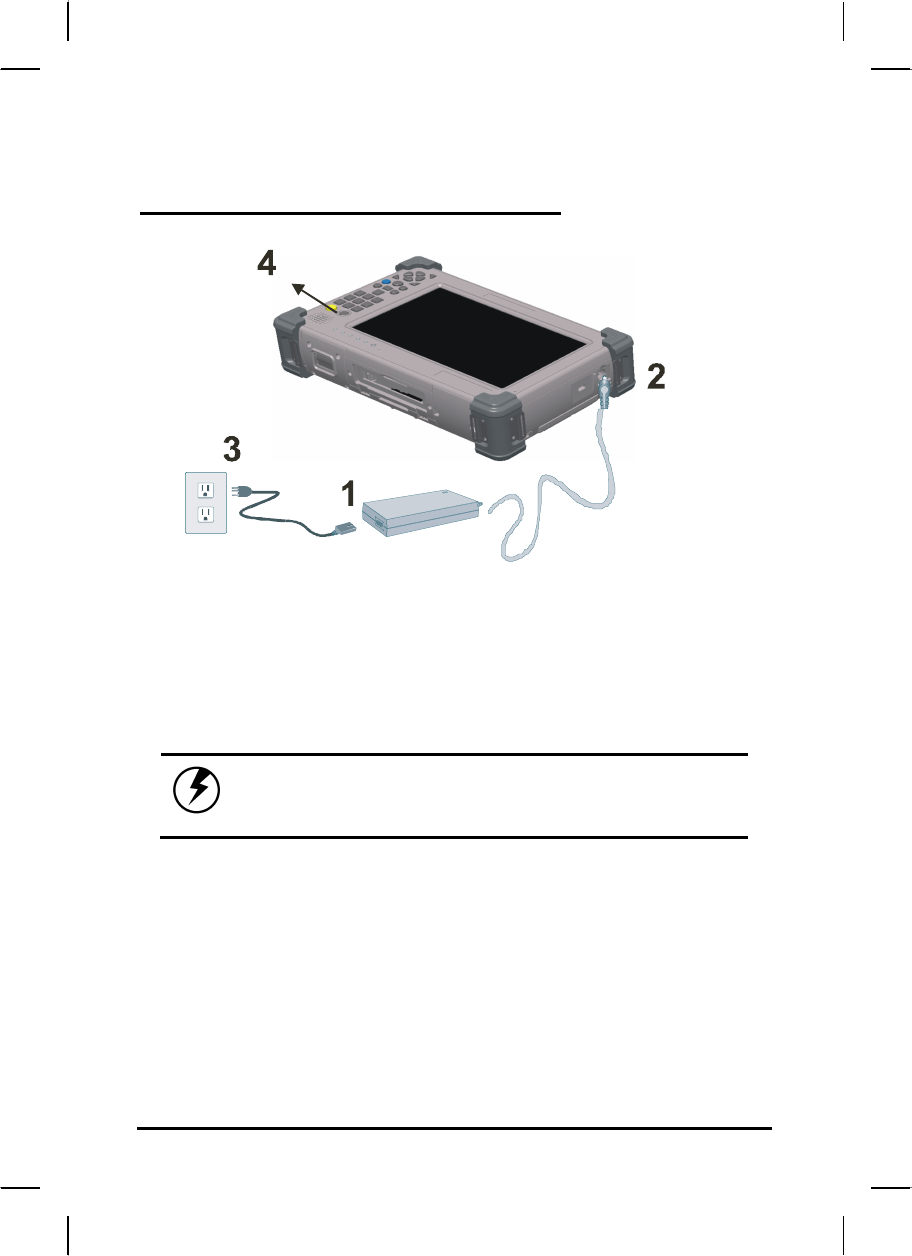
7
Quick Start
Turning on the Tablet PC for the First Time
1. Connect the AC adapter power cord to the AC adapter.
2. Connect the AC adapter to the DC power port on the left side of your
Tablet PC.
3. Connect the AC adapter power cord to an AC outlet.
4. Press the power button to turn on the power.
Note: The battery is not fully charged. Allow
your battery to fully charge before using it
(i.e., before disconnecting AC power).
Loading Windows
The following section is for installing the Windows operating system
only. If you are installing a different operating system, please check
with your vendor for installation details.
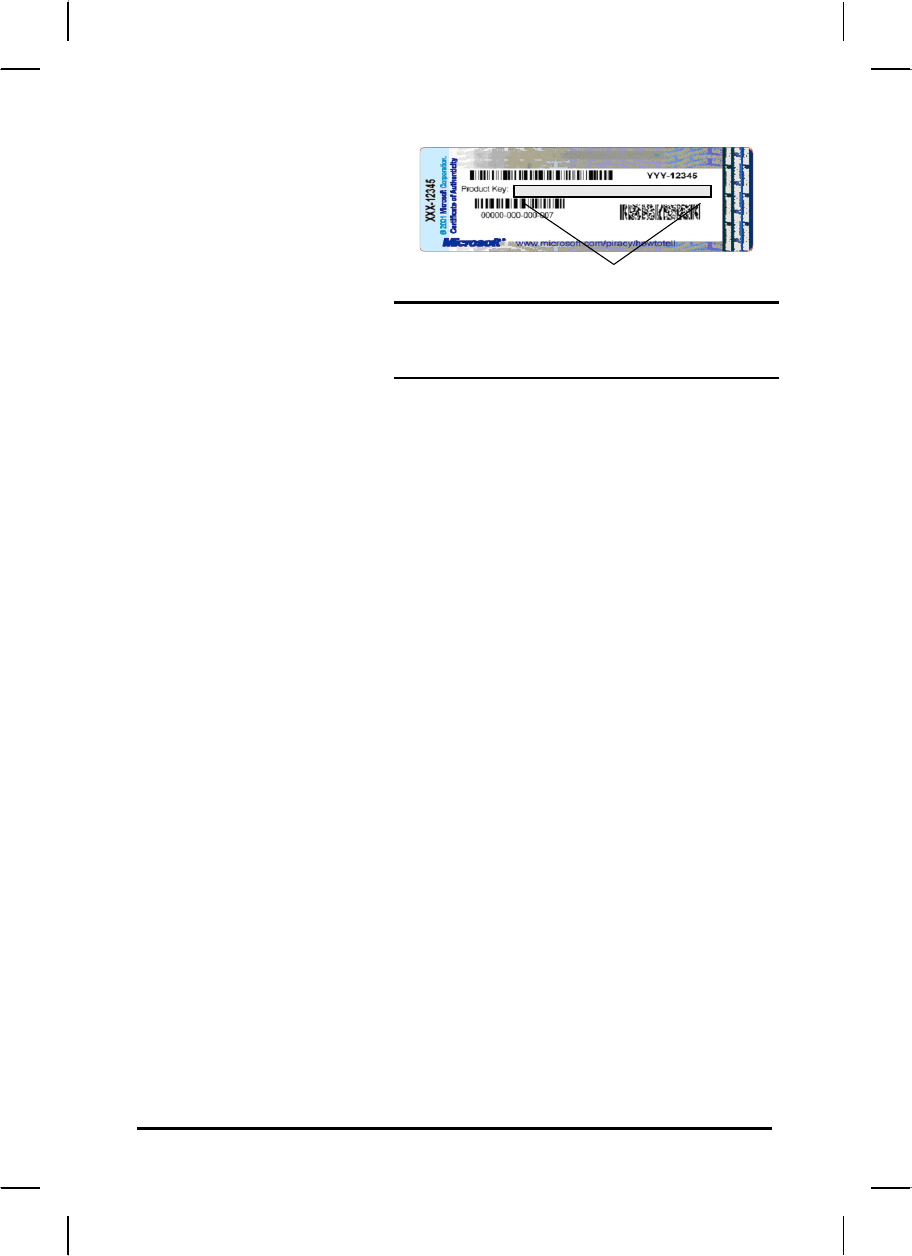
8
Your Tablet PC will
begin loading Windows
once you turn on the
power. Wait a few
seconds for Windows
setup to load. The
Windows setup will
prompt you for the
product key number,
shown to the right:
P r o d u c t k e y n u m b e r
Note: The product key is on a sticker
attached to the bottom of the Tablet PC.
1. Type your name, and, if applicable, the name of your company.
2. Read the End User's License Agreement. Click Next to accept it.
3. Enter the product key number. You can find this on the
Certificate of Authenticity on a sticker attached to the Tablet PC.
Click Finish.
4. The Start Wizard will prompt you to set the date, and your local
time.
After the Start Wizard updates your system settings, the Welcome to
Windows screen will appear. You may disable this feature by
clearing the check box labeled show this screen each time
Windows starts.
Some software comes preloaded with Windows. New users can
familiarize themselves with this software by selecting Programs from
the start menu, then clicking on programs to run them.
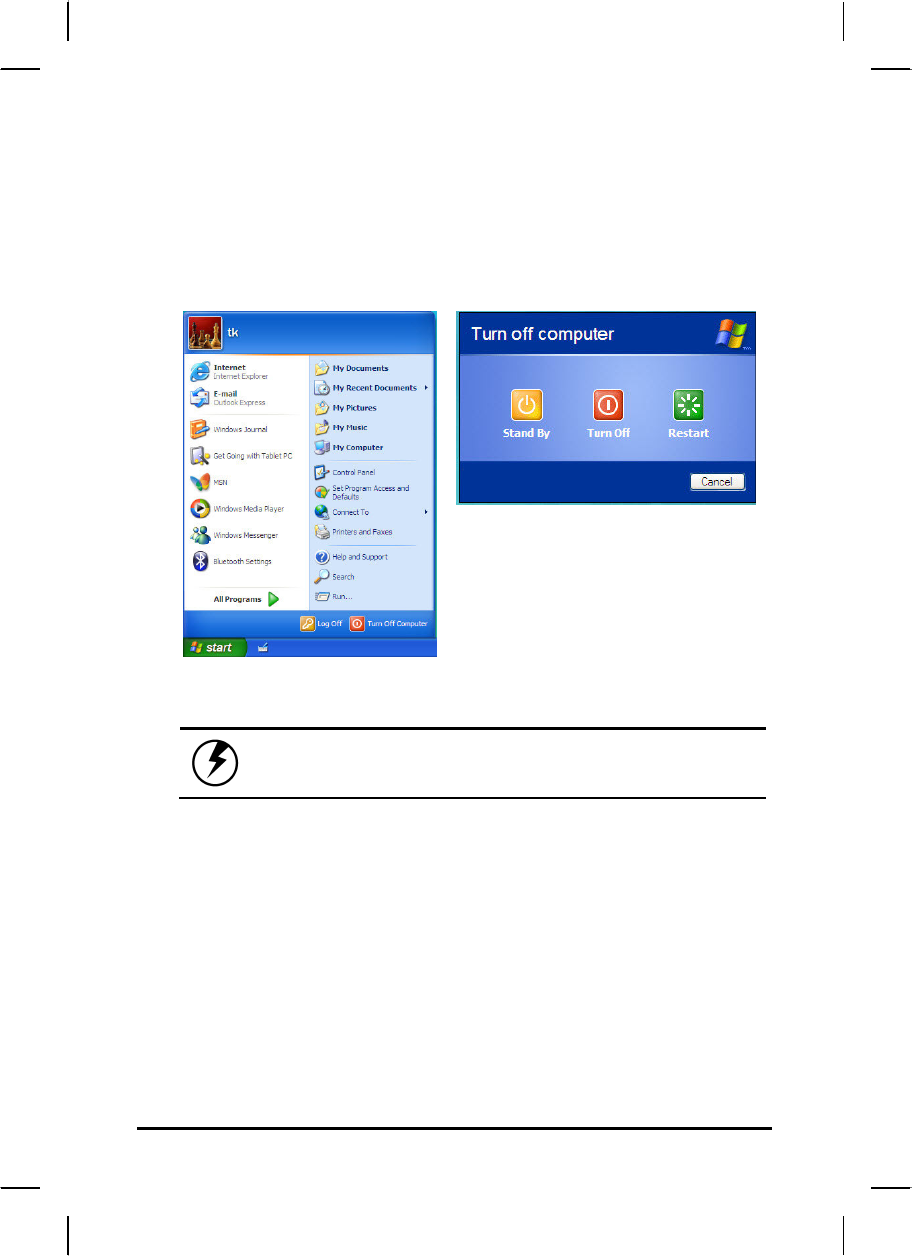
9
Turning off Your Tablet PC
Turning off the Tablet PC Tablet PC properly is important to
maintaining your Tablet PC.
1. On the Start menu, click
Turn off Computer.
2. Click Turn Off in below Windows
screen.
If you are going to be away from the Tablet PC for a short period,
there are ways of conserving power without shutting down the system.
Warning: Shutting off the Tablet PC improperly
may result in data loss.

10
C
Ch
ha
ap
pt
te
er
r
2
2
G
Ge
et
tt
ti
in
ng
g
S
St
ta
ar
rt
te
ed
d

11
Hardware and Software
This chapter introduces the different components and controls of your
Tablet PC, including the hardware components, the software, and the audio
and video systems.
Getting Started
Before you begin using your Tablet PC, read this chapter to familiarize
yourself with the main components installed in the system.
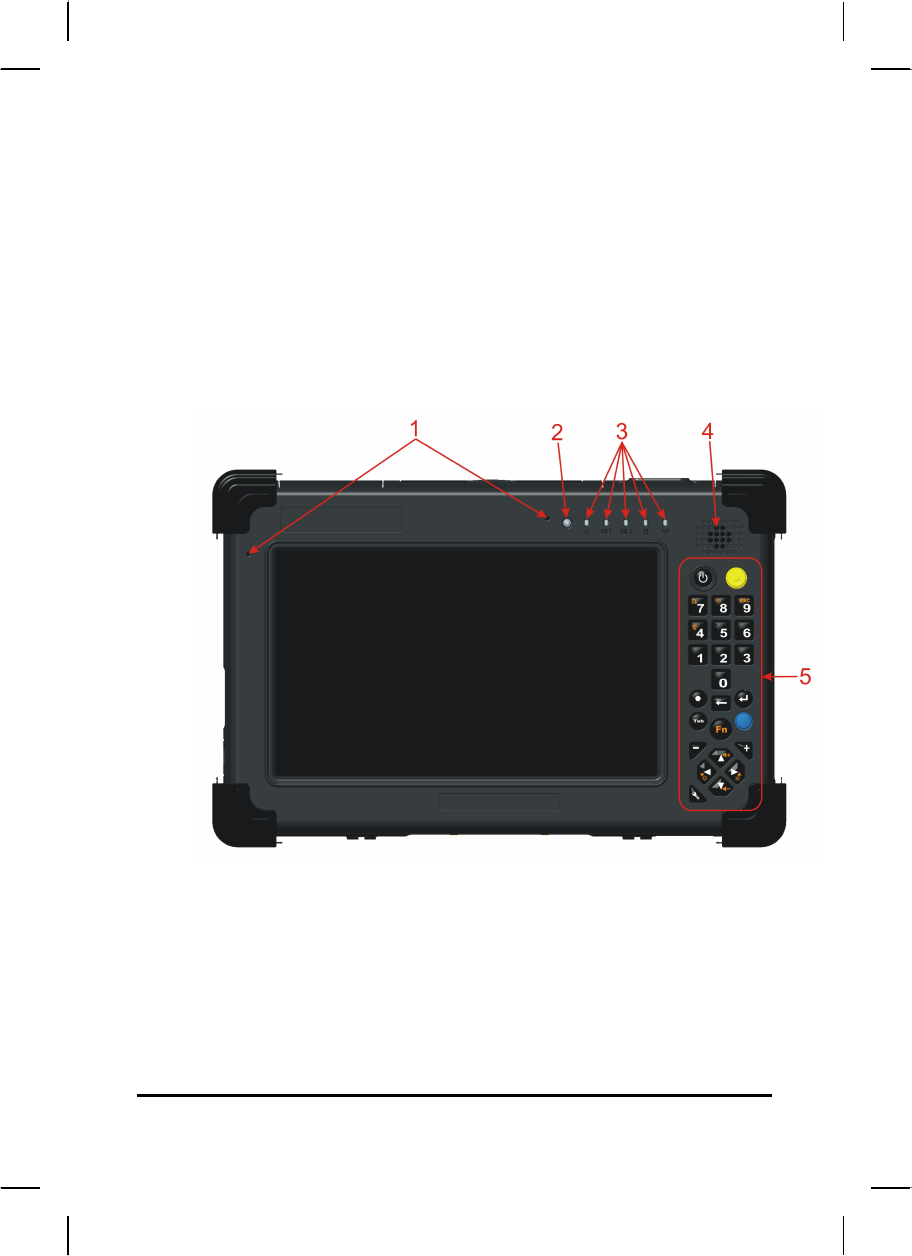
12
Front View
1. Microphone
2. Light sensor
3. LED indicators
4. Speaker
5. Keypad
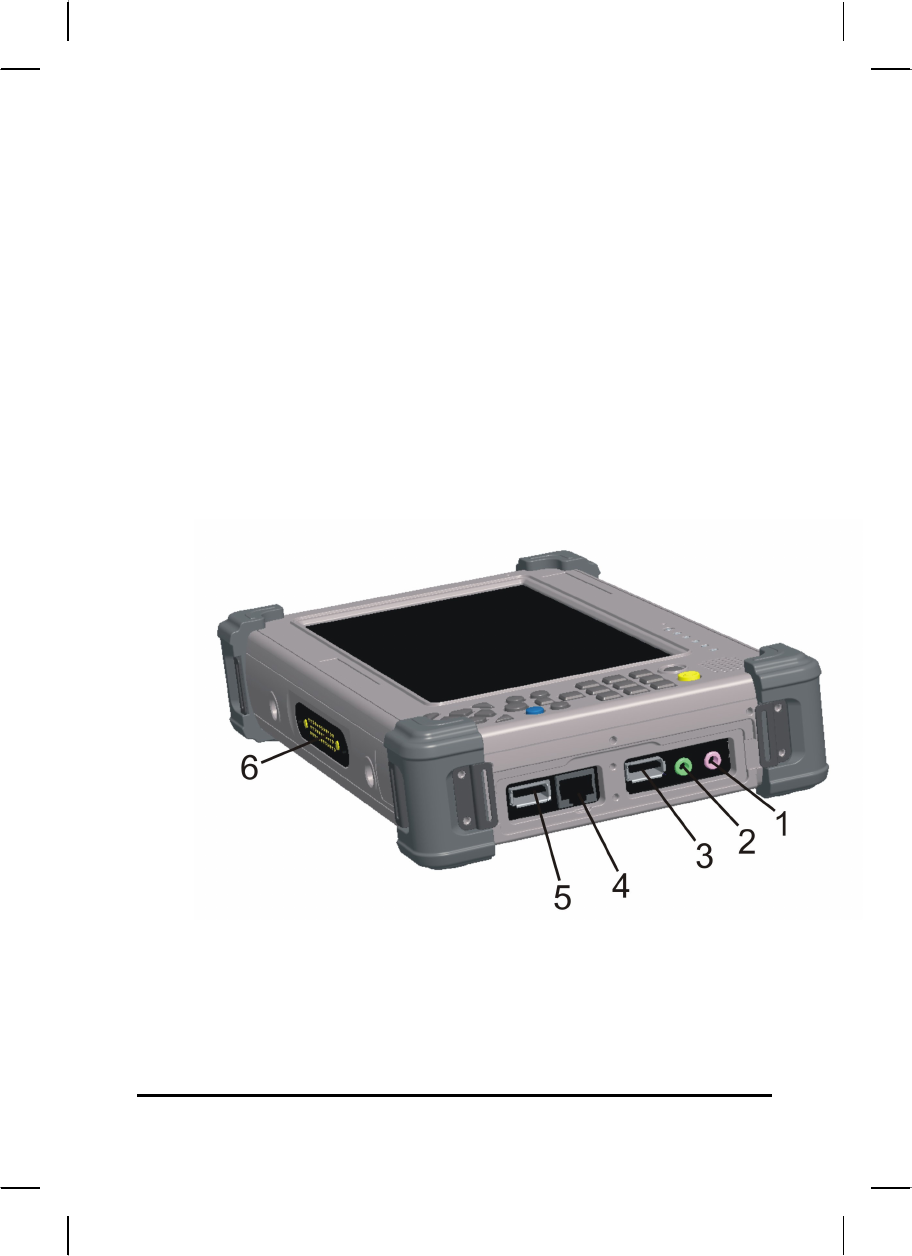
13
Right View
1. Microphone jack
2. Headphone jack
3. USB port
4. RJ-45 jack
5. USB port
6. Docking connector
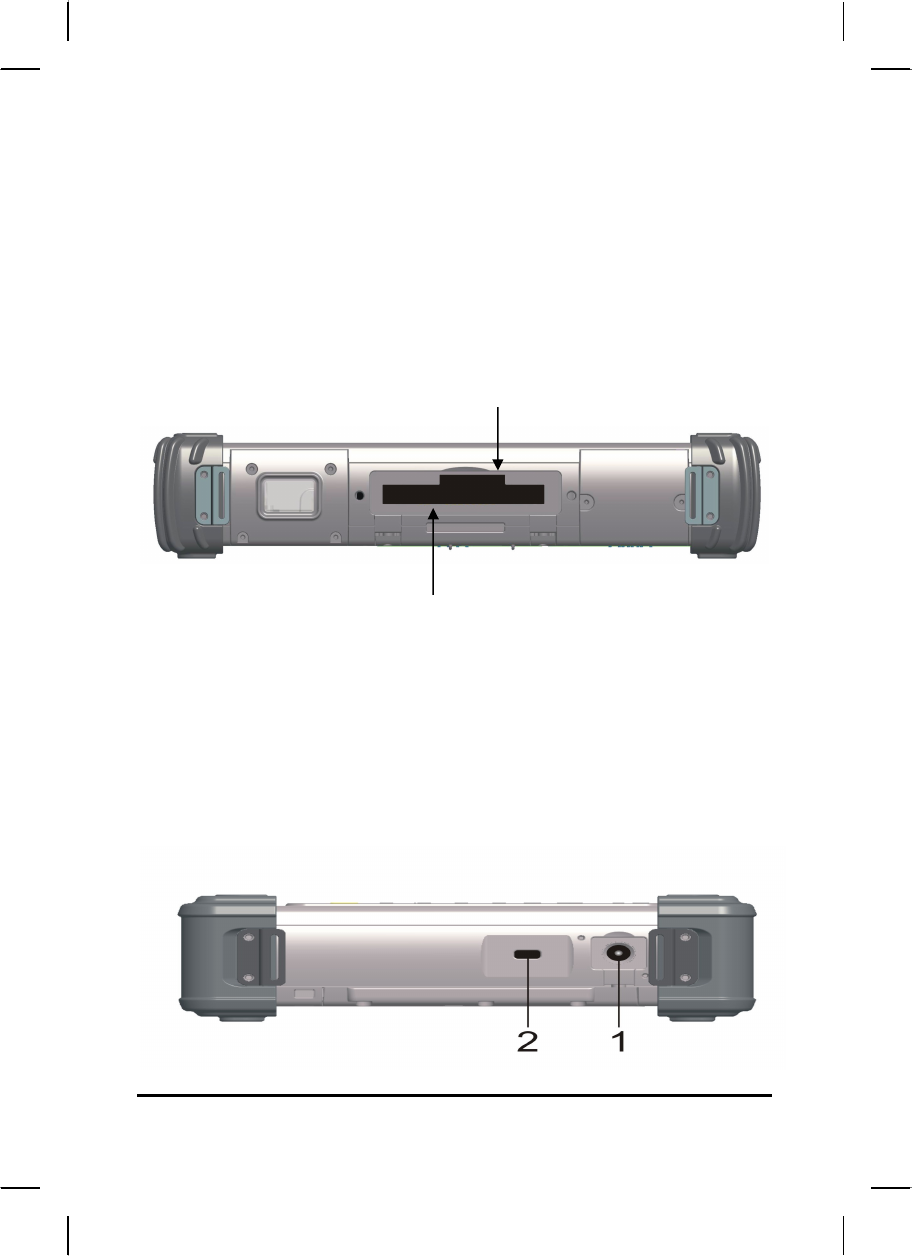
14
Top View
1. SD card slot
2. PCMCIA slot
Left View
1. Security lock slot
2. DC-IN jack
1
2
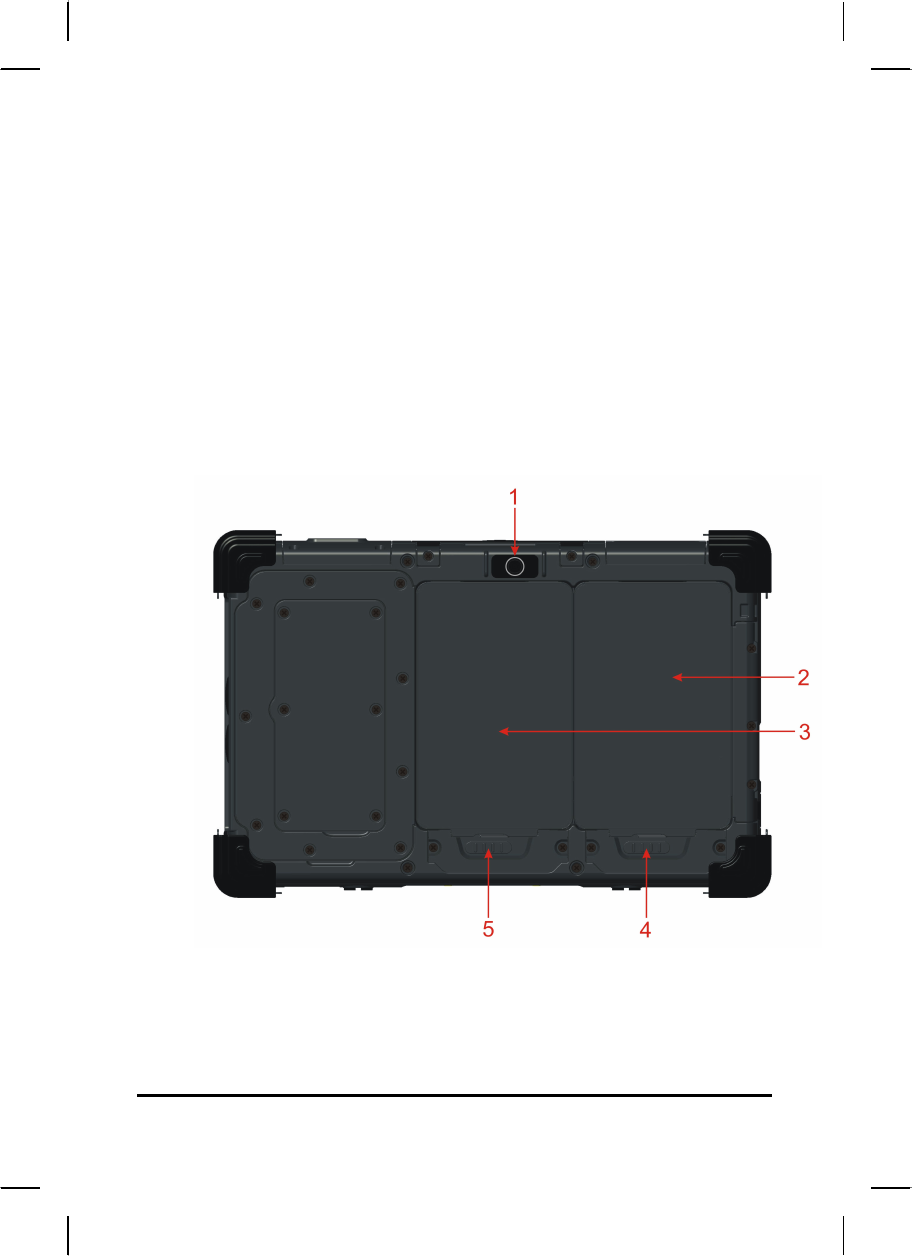
15
Bottom View
1. Camera
2. Battery1
3. Battery2
4. Battery1 latch
5. Battery2 latch
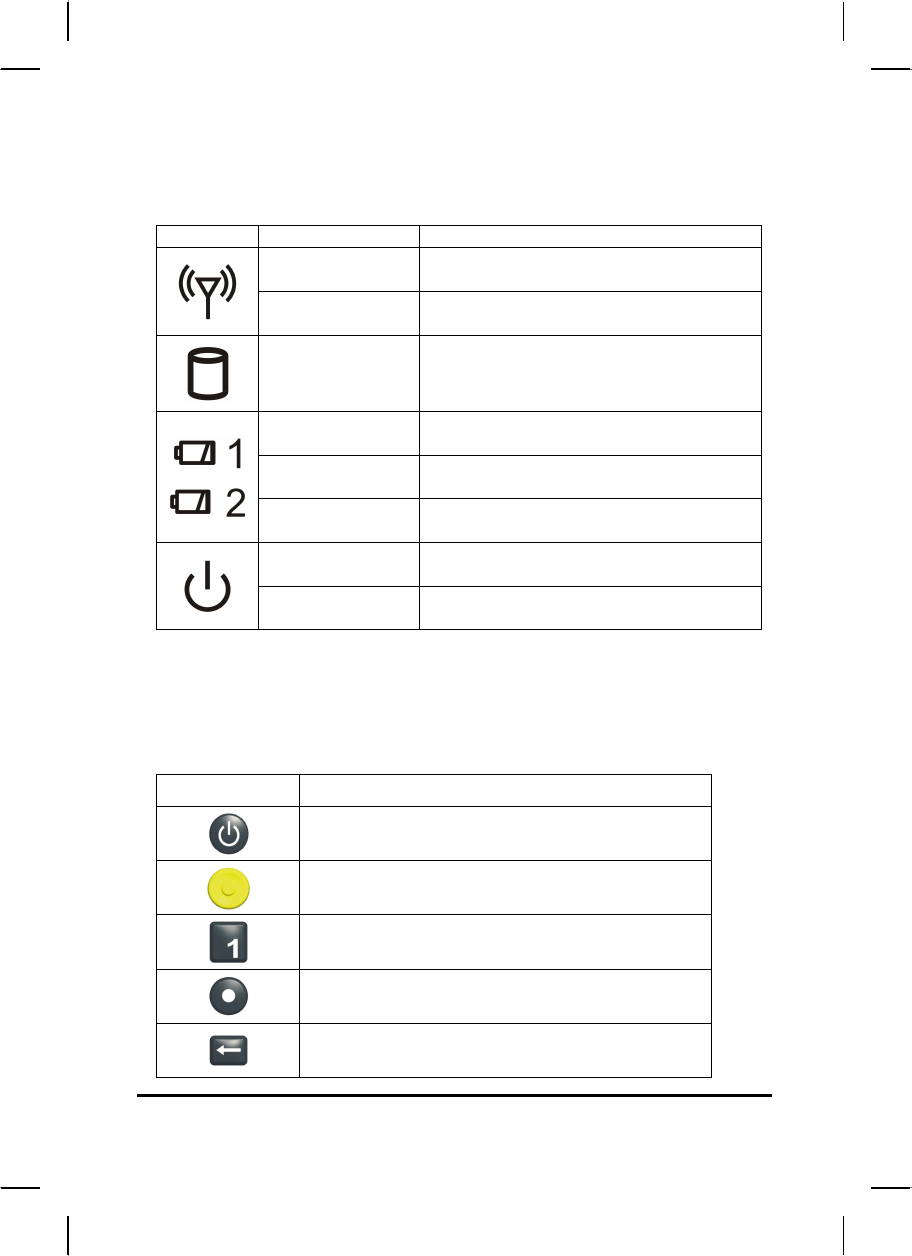
16
LED Indicators
Icon
Light
Description
No light WLAN is Not powered and Bluetooth is
Not powered
Blue WLAN or Bluetooth is enabled
Green Tablet PC is reading from, or writing to
the built-in hard disk.
Green Battery is fully charged
Orange Battery is being charged
Flashing Red Battery is at slow-power state
Green Power is on
Flashing Green System is in standby mode
Front View Buttons
There are 25 keys located at the right side of front panel, their functions are
as follows:
Icon Function
Power Button
Press it to turn on/off the system.
Yellow Button
To trigger Barcode scan function
Numeric Key
Same function as on a standard keyboard.
Decimal-point Key
Same function as on a standard keyboard.
Backspace Button
Same function as on a standard keyboard
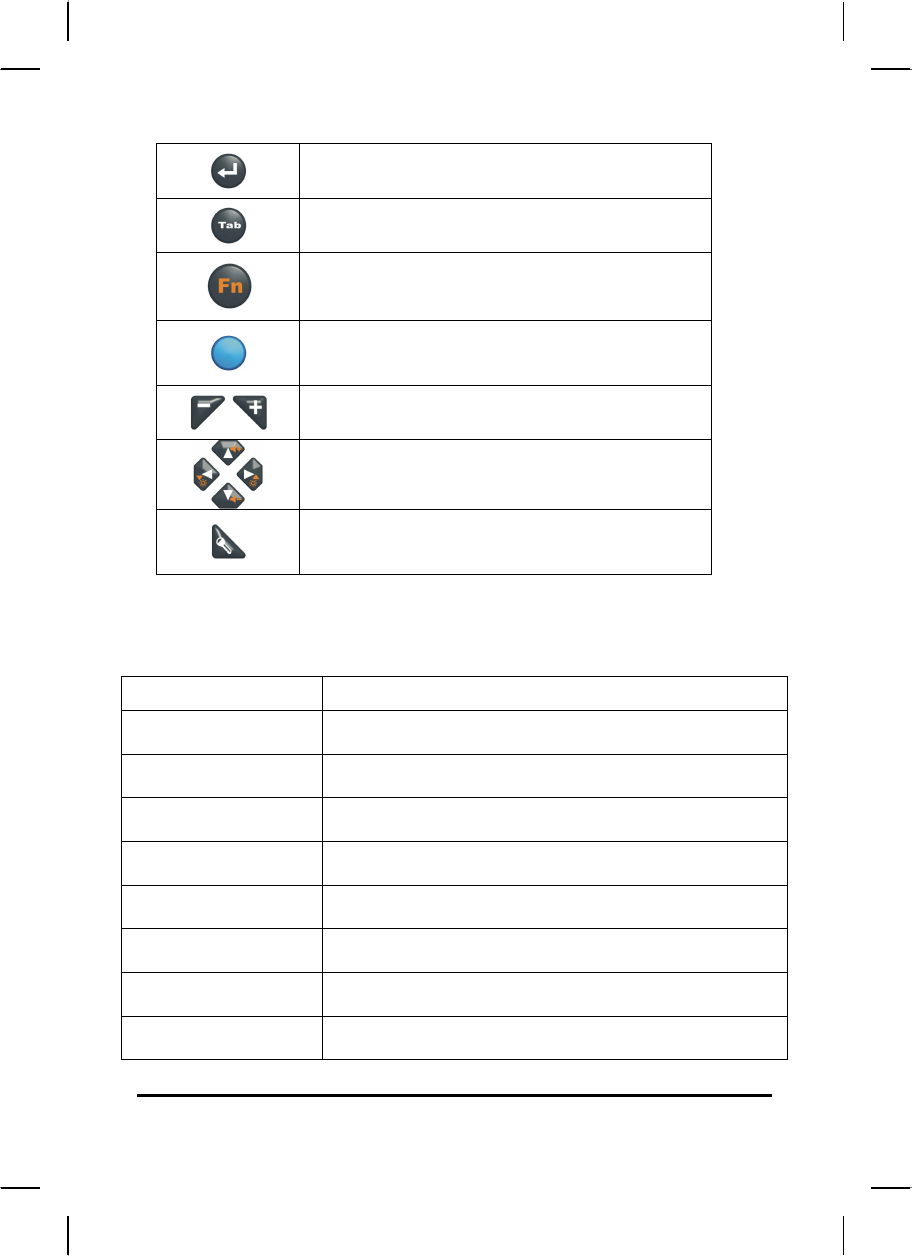
17
Enter Button
Same function as on a standard keyboard.
Tab Button
Same function as on a standard keyboard.
Function Button
Access to secondary operation of some buttons
(shown in the illustration above)
Blue Button
Can be assigned to launch specific windows base
program as a quick-launcher
Plus/Minus Button
Same function as on a standard keyboard.
UP/ Down/ Left/ Right Button
Same function as on a standard keyboard.
Security Button
Similar function as pressing Ctrl+Alt+Delete on a
standard keyboard.
Function Keys
Hold the Fn key while pressing the function key.
Function key Description
Fn + Up Volume up
Fn + Down Volume down
Fn + Left Brightness Decrease
Fn + Right Brightness Increase
Fn + 4 Trigger keypad LED backlight
Fn + 7 Screen Rotate by 90-degree
Fn + 8 Turn on/off WLAN and Bluetooth devices
Fn + 9 Escape same as standard Keyboard

18
C
Ch
ha
ap
pt
te
er
r
3
3
M
Ma
ak
ki
in
ng
g
C
Co
on
nn
ne
ec
ct
ti
io
on
ns
s
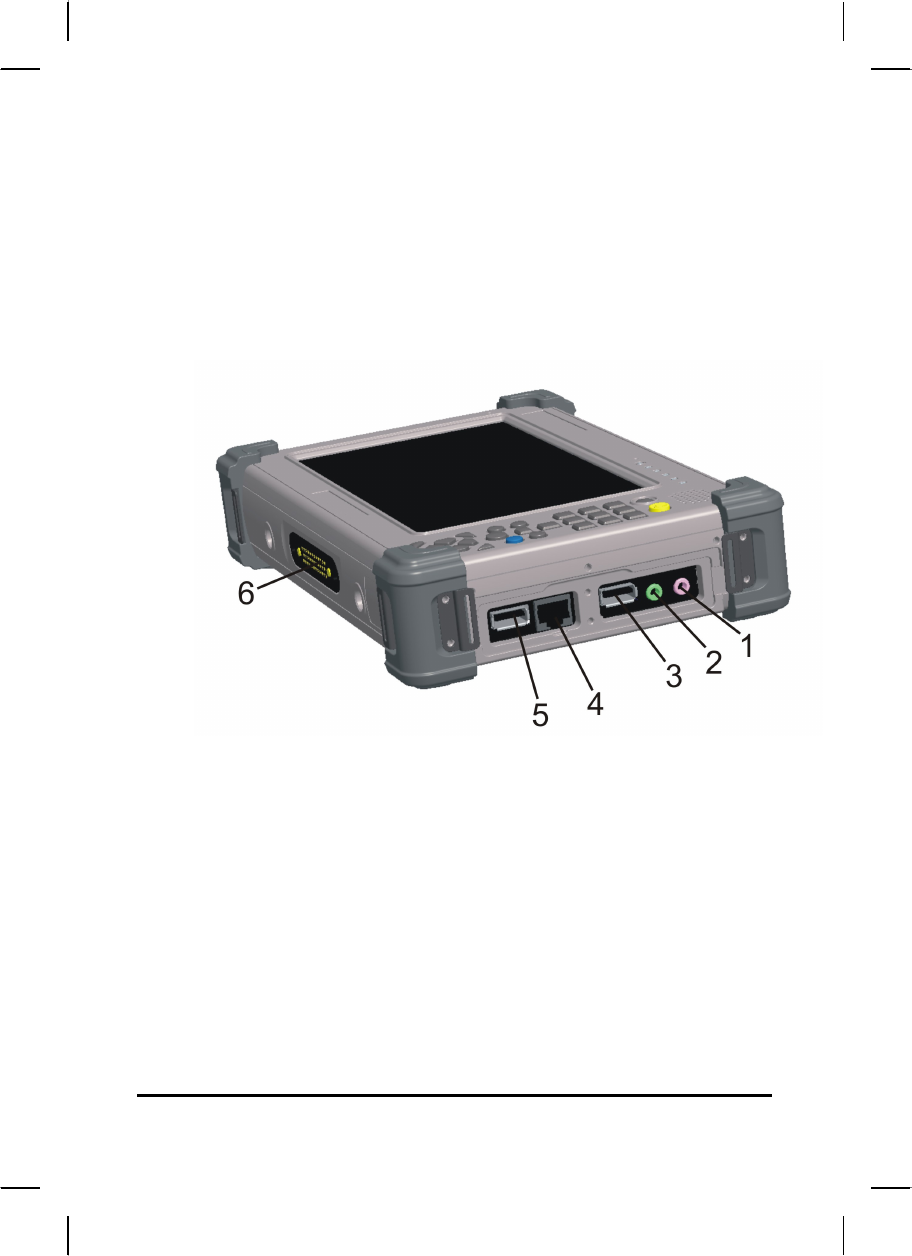
19
Making Connections
Your Tablet PC is equipped with a full array of ports and connectors,
including standard input/output (I/O) ports for quickly and easily
adding peripheral devices.
Right Side and Bottom Side Connectors
1. Microphone-in Jack
Connect a microphone this jack to record audio.
2. Headphone Jack
Connect a stereo headset or external speakers to this jack to listen
to multimedia.
3. & 5. USB (Universal Serial Bus) Ports
The Universal Serial Bus (USB) is the latest standard for attaching
monitors, input devices, scanners, and other devices to a PC. USB
devices can be chained together on a single cable.
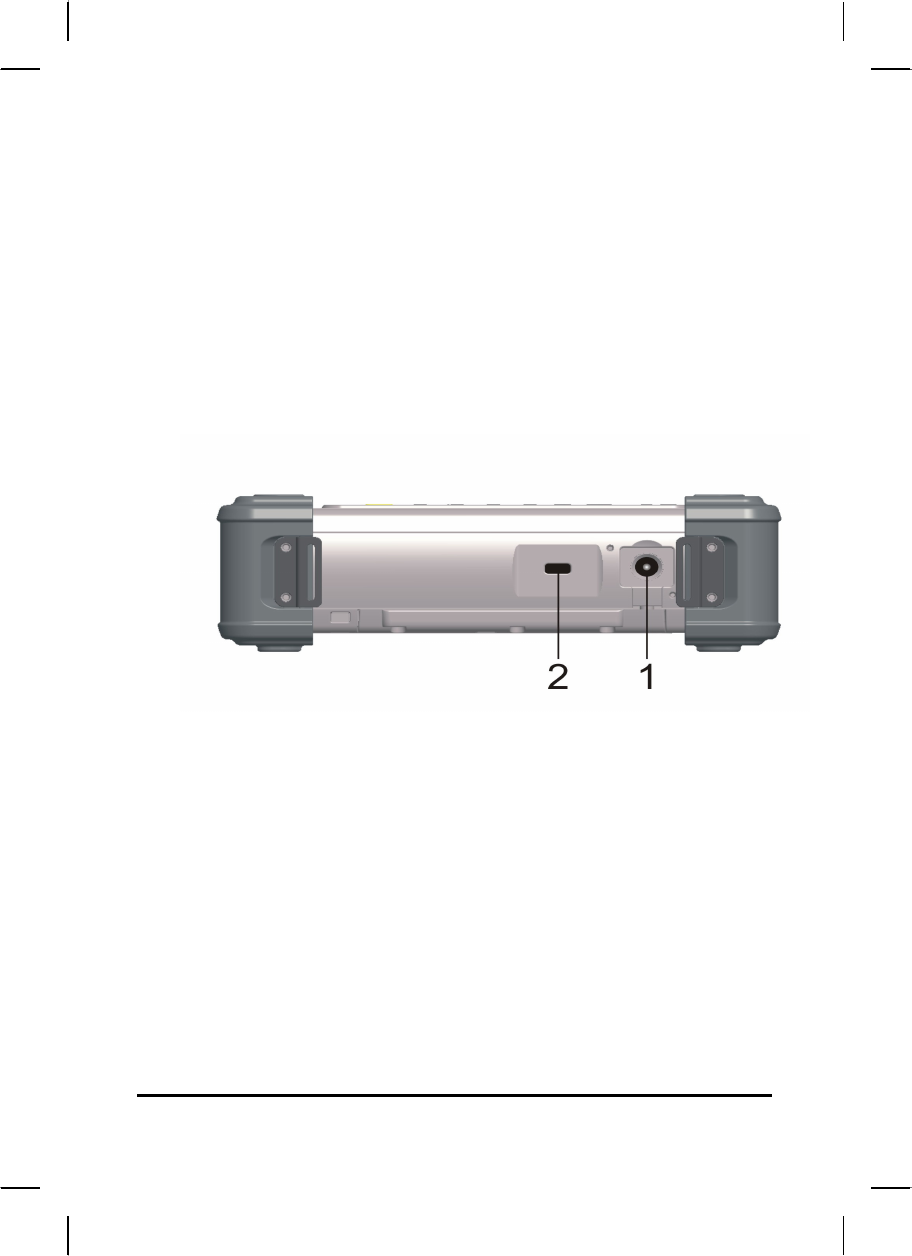
20
4. LAN RJ-45 Jack
With the built-in Ethernet LAN, you can make LAN connection
without installing PC cards. Connection speed is 10/100 Mbps.
6. Multi IO connector
The Connector is reserved for specific purpose which is used to
connect to customer’s device.
Left Side Connectors
1. DC-IN Jack
Connect with the attached AC adapter
2. Security Lock Slot
Install an antitheft device to this lock.
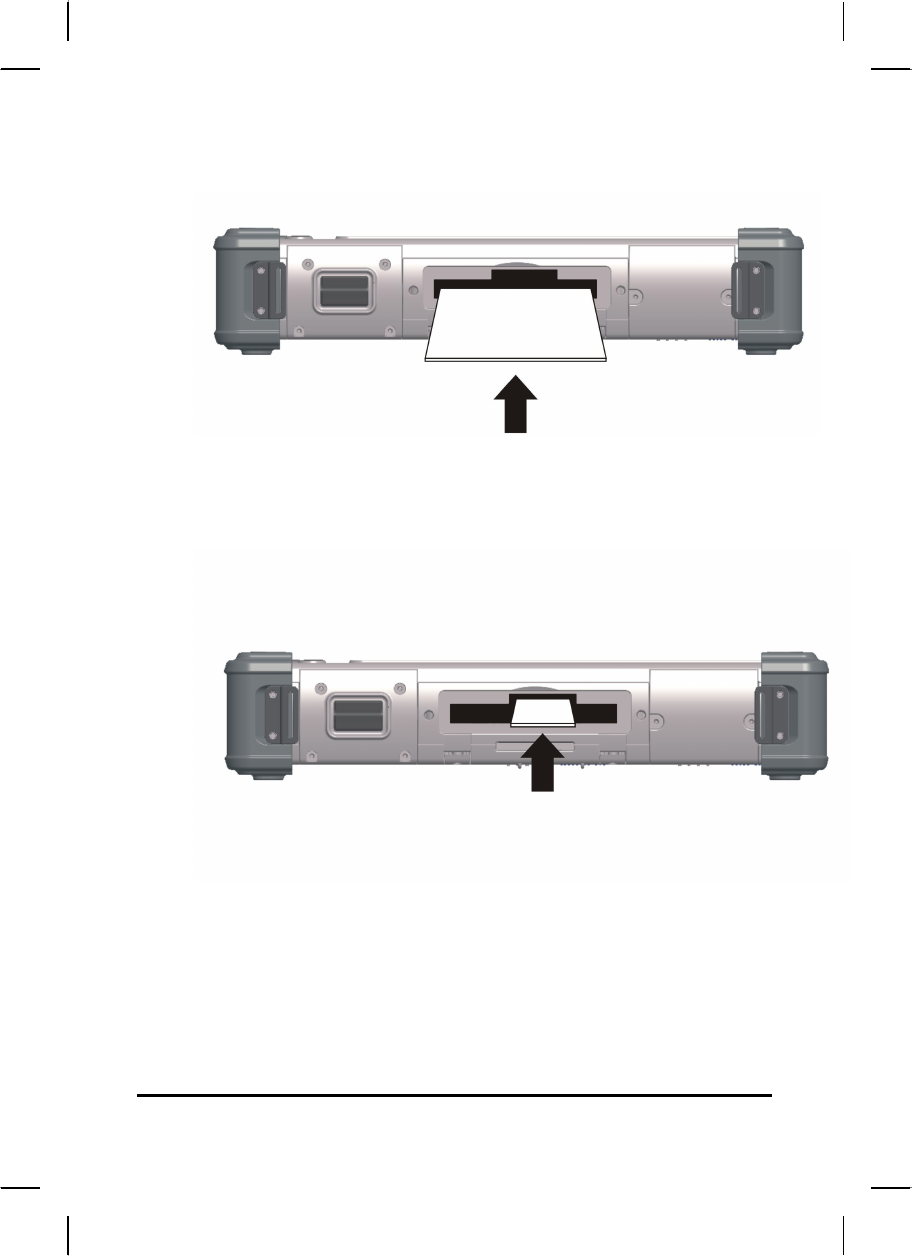
21
3. Top Side Connectors
1. PC Card Slot (PCMCIA)
Insert a PC Card (PCMCIA) card in the PC Card Slot as shown above
until it snaps into place. Press the eject button to release the card.
2. SD Card slot
The SD Card slot cab be used as an interface between you Tablet
PC and a variety of devices. Insert an SD card in the SD card slot as
shown above until it snaps into place.
.

22
C
Ch
ha
ap
pt
te
er
r
4
4
P
Po
ow
we
er
r
M
Ma
an
na
ag
ge
em
me
en
nt
t
A
An
nd
d
U
Us
si
in
ng
g
S
So
of
ft
tw
wa
ar
re
e
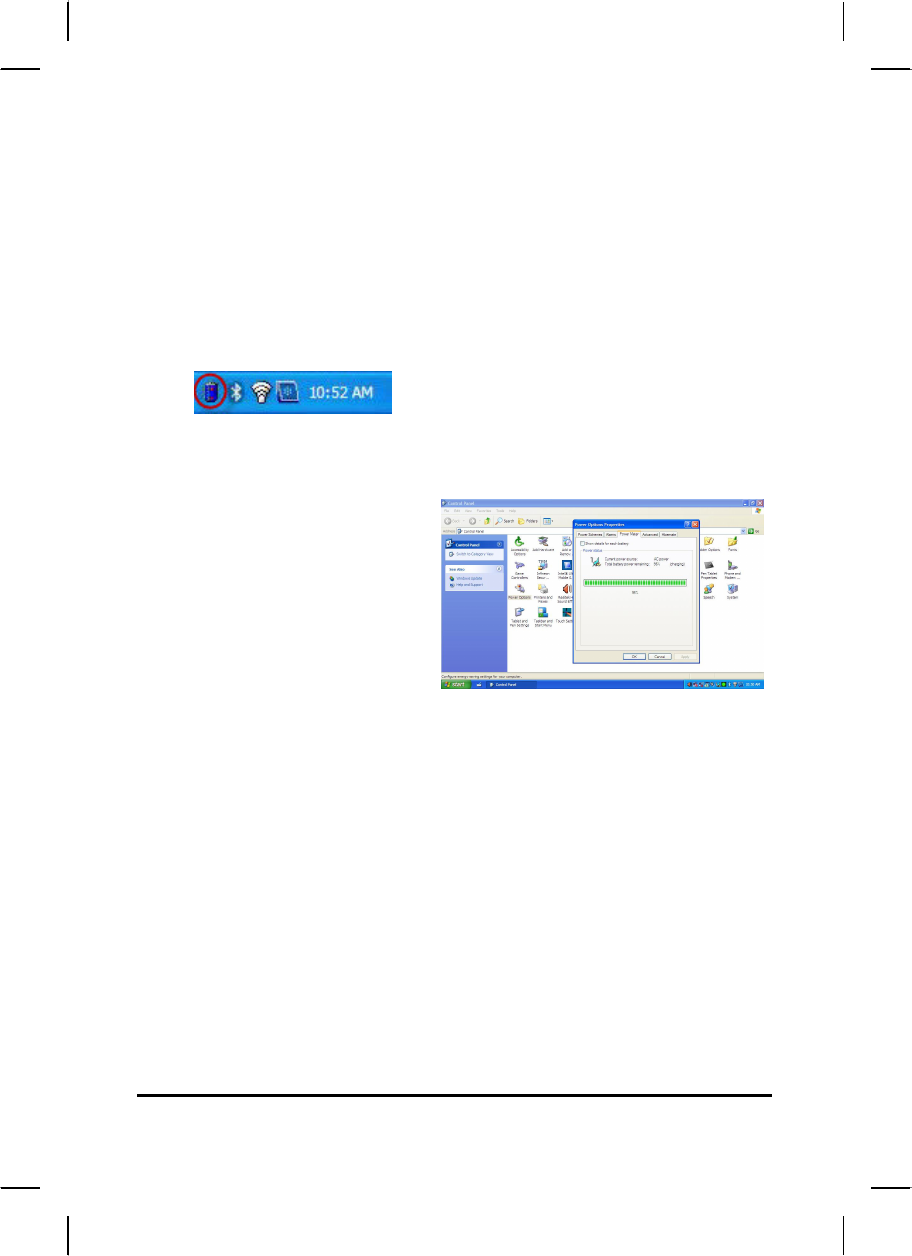
23
Power Management
Checking the Battery Level
You can check the remaining battery power in the Windows® battery status
indicator located at the lower right-hand corner of the task tray. The Battery
Status icon only appears in the task tray while the unit is running on the
battery power but not while the unit is running off an external power source
through the AC adaptor.
Enter Monitoring Battery Power
There are two ways to
monitor how much power the
battery has left.
1. Click Start / Control Panel
/ Power Options then click
Power Meter.
2. Moving the cursor to the
battery icon on the
taskbar is the simplest
way to check on battery
power status.
If you do not see the battery icon, enable it in Start / Control Panel /
Power Options. Choose the Advanced tab and click “Always show
icon on the taskbar.”
Low Battery Alarms
How your Tablet PC responds to a low battery condition is set under
Start / Control Panel / Power Options / Alarms.
Two different power alarms can be enabled or disabled: the Low
Battery Alarm, and the Critical Battery Alarm.
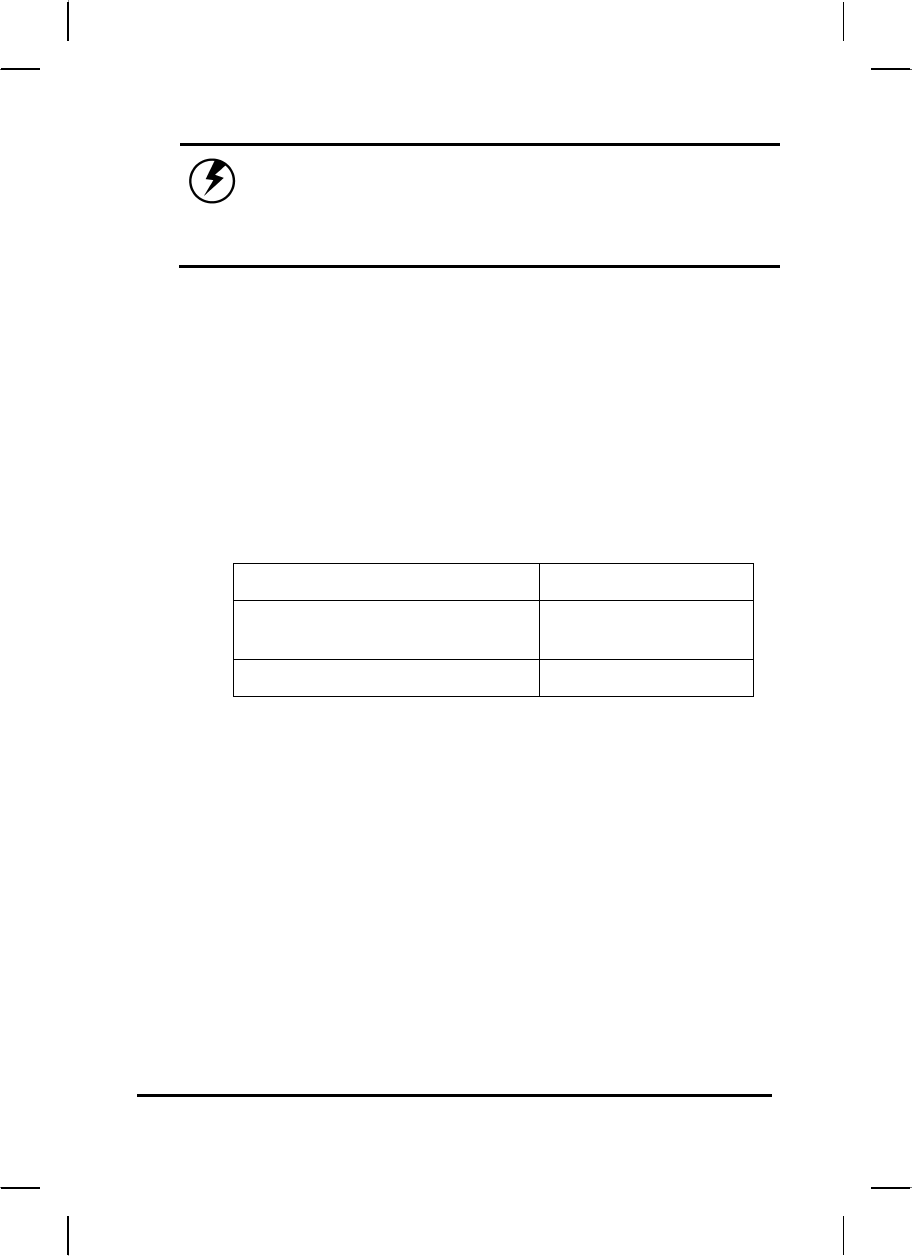
24
Warning: When battery power is low, the battery
indicator will flash red, and the alarm will
display a warning on your screen. Take immediate
action, such as saving files or connecting to the
AC adapter, or data may be lost.
Battery Charging
When you use the AC adapter to connect your Tablet PC to a power
outlet, the internal battery will automatically begin to recharge. While
the battery is charging, the Battery Charge icon on the Indicator
panel will be active after 6~12 seconds. When the battery is fully
charged, the Battery Charge icon will become Green.
If your Tablet PC is turned off, a fully discharged battery will take
about 4 hours to recharge.
Refer to the following table:
Two Battery Packs Charging Time
System On
(Under Screen Saver Mode) Approx. 8 hours
System Off (suspend to RAM) Approx. 4 hours
When to Replace the Battery Pack
Over time, the battery's capacity gradually decreases. We recommend that
you replace your battery pack when you notice that it begins to store
significantly less charge.
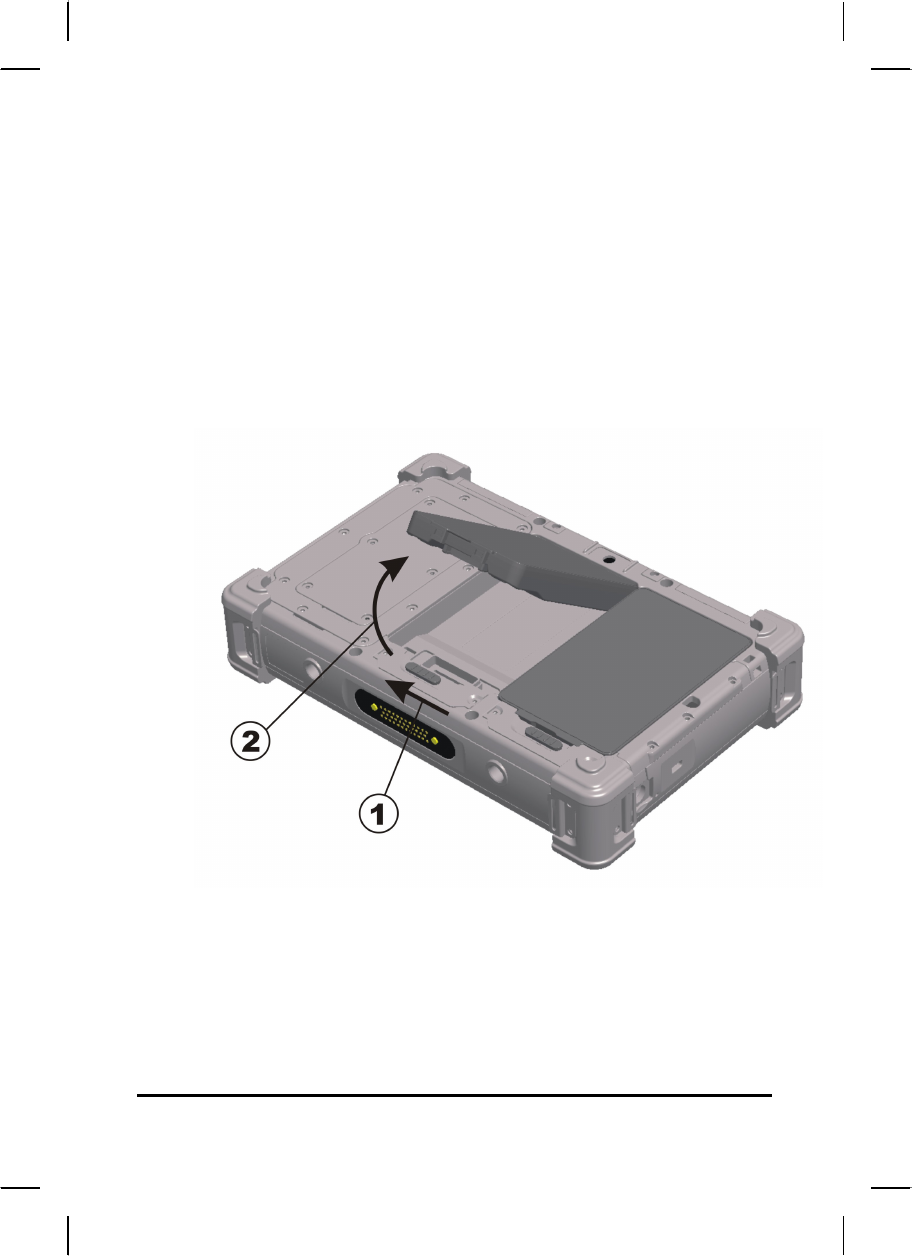
25
Changing the Battery Pack
1. Slide the battery release latch,
2. Then remove the battery,
3. Align the back side of the battery pack with the battery bay and
press the top side of battery pack to install it,
4. Move the latch to lock back into position.
Heat Considerations
The Tablet PC processor has been specially designed to consume
little power, and generates very little heat. However, working in a hot
environment, or working for long periods may raise the temperature.
If the temperature continues to rise, processor activity will be
reduced. You may notice a slight loss of performance when this
happens.
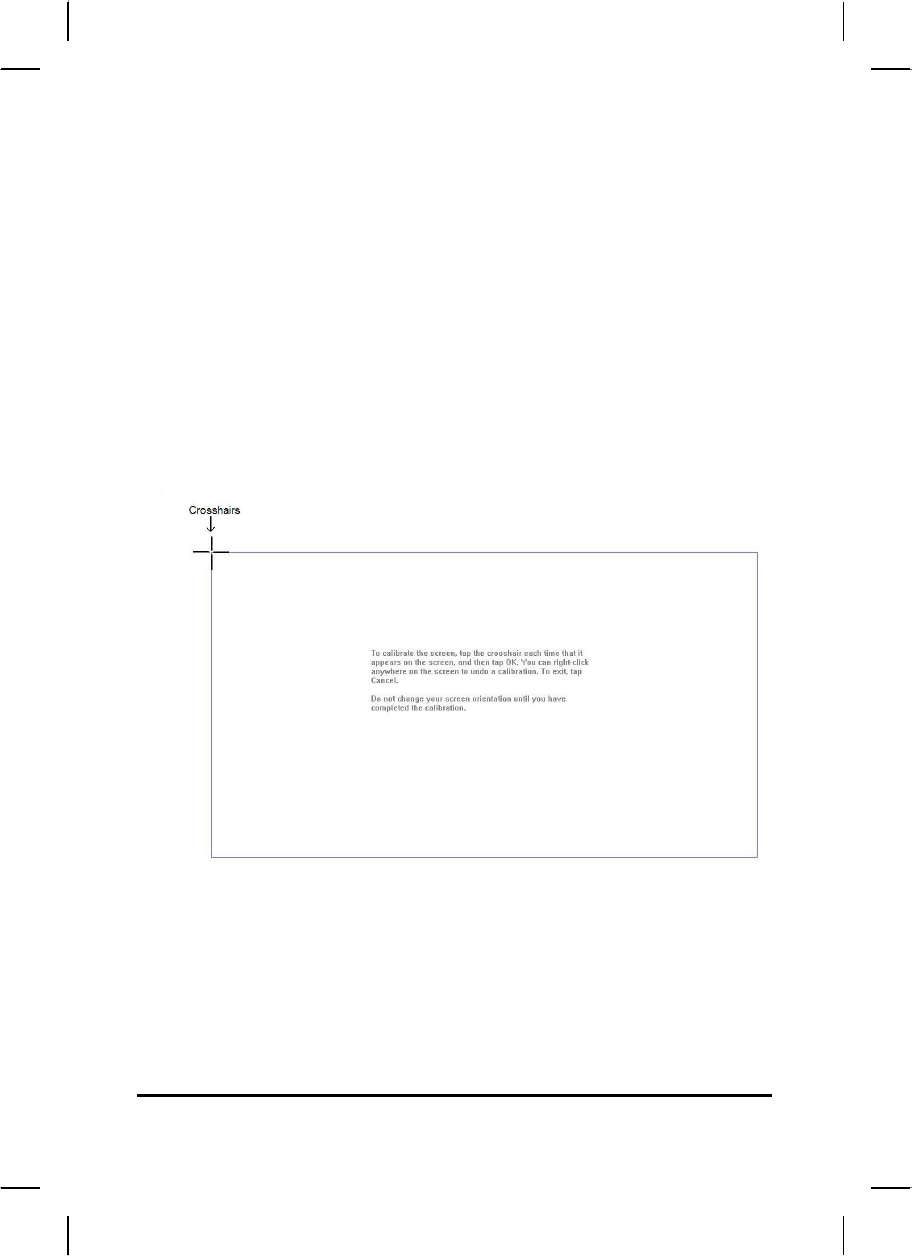
26
Using Software
Digitizer Calibration <For Selected Model>
The touch screen is a thin membrane on the top of the LCD that reth-
hsponds to mechanical pressure on the screen’s surface. The cursor on the
screen is controlled by the stylus. If you notice the stylus tip touch-point not
matching up with the cursor, you can recalibrate the touch screen.
Calibrating the Digitizer
1. Click the Windows® Start button > Control Panel > Switch to Classic
View > Pen Tablet Properties > Calibrate.
2. Under the Setting tab, click on the [Calibrate…] button to activate the
calibration screen.
3. Hold the pen and position your head as you normally do when
working with the tablet.
4. Use the pen tip to click on the center of the crosshairs. The wheel
moves to another location on-screen.
5. Click [OK] to accept the calibration.
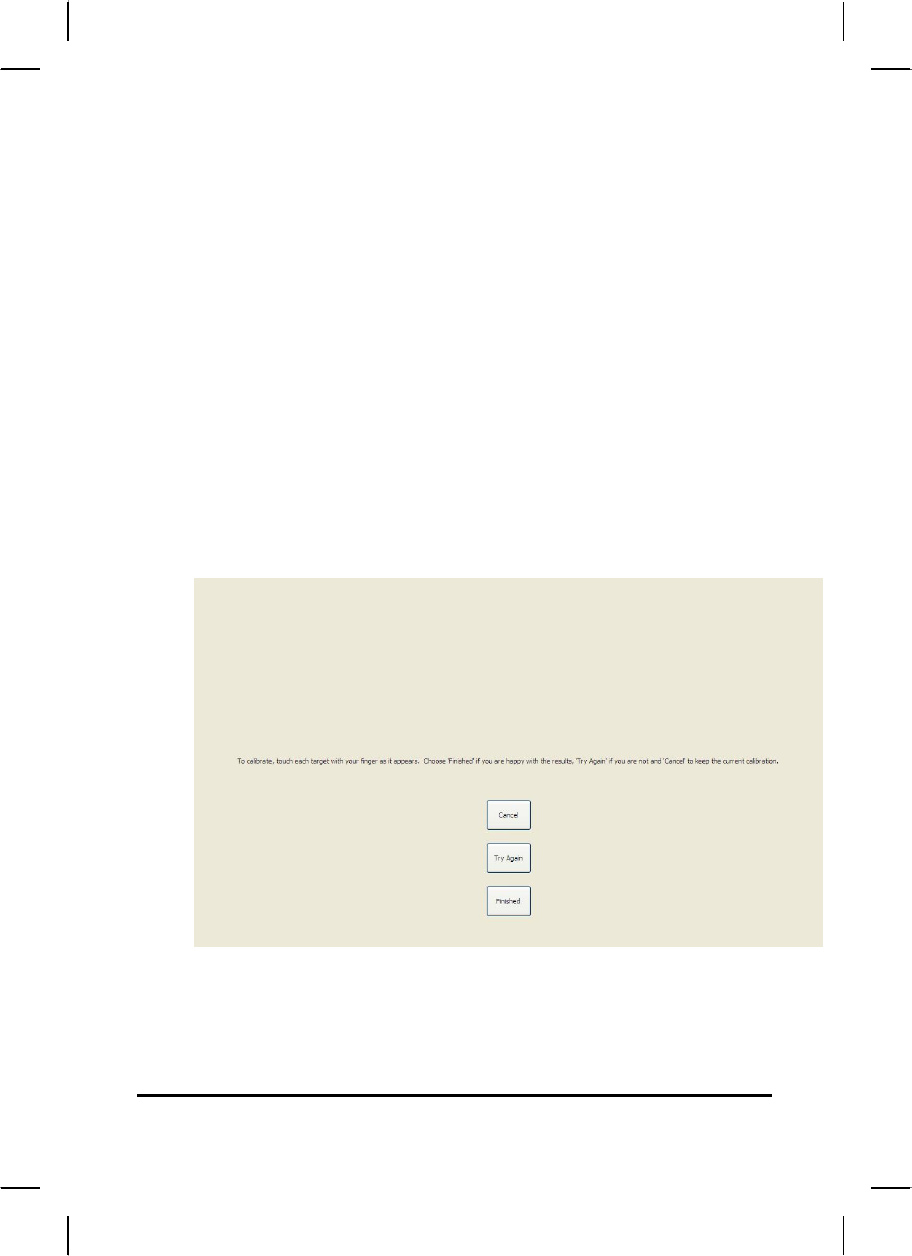
27
Calibrating the Touch Screen
1. Click the Windows® Start button > Control Panel > Switch to Classic
View > Touch Settings.
2. Under the calibration tab, click on the [Calibrate…] button to activate
the calibration screen.
3. Hold the pen and position your head as you normally do when
working with the tablet.
4. Use the pen tip to click on the center of the crosshairs. The wheel
moves to another location on-screen.
5. Test the alignment by positioning the pen at a few different points on
the display. Click [Finished] to accept the calibration. Click [Try Again]
to recalibrate.
6. Be sure to read the directions in the calibration screen for detailed
instructions and additional options.

28
A
Ap
pp
pe
en
nd
di
ix
x
A
A
S
St
ta
at
te
em
me
en
nt
ts
s

29
Statements
Federal Communications Commission Statement
This equipment has been tested and found to comply with the limits
for a Class B digital device, pursuant to Part 15 of the FCC Rules.
These limits are designed to provide reasonable protection against
harmful interference in a residential installation. This equipment
generates, uses, and can radiate radio frequency energy and, if not
installed and used in accordance with the instructions, may cause
harmful interference to radio communications. However, there is no
guarantee that interference will not occur in a particular installation. If
this equipment does cause harmful interference to radio or television
reception, which can be determined by turning the equipment off and
on, the user is encouraged to try to correct the interference by one or
more of the following measures:
1. Reorient or relocate the receiving antenna.
2. Increase the separation between the equipment and the receiver.
3. Connect the equipment into an outlet on a circuit different from
that to which the receiver is connected.
4. Consult the dealer or an experienced radio/TV technician for
help.
Shielded interconnect cables and shielded AC power cable must be
employed with this equipment to insure compliance with the pertinent
RF emission limits governing this device. Changes or modifications
not expressly approved by the system's manufacturer could void the
user's authority to operate the equipment.
CAUTION
Any changes or modifications not expressly approved by the party
responsible for compliance could void the user's authority to operate
the equipment.
RF exposure warning
The equipment complies with FCC RF exposure limits set forth foran
uncontrolled environment. The equipment must not be co-located or
operating in conjunction with any other antenna or transmitter.
Radiation Exposure Statement:

30
This equipment complies with FCC radiation exposure limits set
forth for an uncontrolled environment. End users must follow the
specific operating instructions for satisfying RF exposure
compliance. To maintain compliance with FCC RF exposure
compliance requirements, please follow operation instruction as
documented in this manual.
The availability of some specific channels and/or operational
frequency bands are country dependent and are firmware
programmed at the factory to match the intended destination. The
firmware setting is not accessible by the end user.
Declaration of Conformity
This device complies with part 15 of the FCC rules. Operation is
subject to the following conditions:
• This device may not cause harmful interference
• This device must accept any interference received, including
interference that may cause undesired operation.
European Notice
CE Declaration of Conformity
For the following equipment: Tablet built-in 802.11a/b/g/n WLAN
module
Is herewith confirmed to comply with the requirements set out in the
Council Directive on the Approximation of the Laws of the Member
States relating to Electromagnetic Compatibility (2004/105/EC), Low-
voltage Directive (2006/95/EC) , the procedures given in European
Council Directive 1999/5/EC .

31
The equipment was passed. The test was performed according to the
following European standards:
• EN 300 328 V.1.4.1 (2003-04)
• EN 301 489-1 V.1.3.1 (2001-09) / EN 301 489-17 V.1.1.1
(2000-09)
• EN 301 893 V.1.2.2 (2003-06)
• EN 50371: 2002
• EN 60950: 2000
Regulatory statement (R&TTE / WLAN IEEE 802.11b
& 802.11g)
European standards dictate maximum radiated transmit power of
100mW EIRP and frequency range 2.400-2.4835GHz; In France, the
equipment must be restricted to the 2.4465-2.4835GHz frequency
range and must be restricted to indoor use.
Safety Caution
To reduce the risk of fire, use only No. 26 AWG or larger
telecommunication line cord.
IMPORTANT SAFETY INSTRUCTIONS
When using your telephone equipment, basic safety precautions
should always be followed to reduce the risk of fire, electric shock
and injury to persons, including the following:
Do not use this product near water, for example, near a bathtub,
wash bowl, kitchen sink or laundry tub, in a wet basement or near a
swimming pool.
Avoid using a telephone (other than a cordless type) during an
electrical storm. There may be a remote risk of electric shock from
lightning.
Do not use the telephone to report a gas leak in the vicinity of the
leak.

32
Use only the power cord and batteries indicated in this manual. Do
not dispose of batteries in a fire. They may explode. Check with local
codes for possible special disposal instructions.
Battery Disposal
THIS PRODUCT CONTAINS LITHIUM-ION BATTERY PACKS. IT
MUST BE DISPOSED OF PROPERLY. CONTACT LOCAL
ENVIRONMENTAL AGENCIES FOR INFORMATION ON
RECYCLING AND DISPOSAL PLANS IN YOUR AREA.
CAUTION FOR ADAPTER
THIS TABLET PC IS FOR USE WITH MODEL NO. FSP065-RAB
BATTERY CAUTION
DANGER OF EXPLOSION IF BATTERY IS INCORRECTLY REPLACED.
REPLACE ONLY WITH THE SAME OR EQUIVALENT TYPE RECOMMENDED BY
THE MANUFACTURER. DISPOSE OF USED BATTERIES ACCORDING TO THE
MANUFACTURER'S INSTRUCTIONS.
Regulatory information / Disclaimers
Installation and use of this Wireless LAN device must be in strict
accordance with the instructions included in the user documentation
provided with the product. Any changes or modifications (including
the antennas) made to this device that are not expressly approved
by the manufacturer may void the user’s authority to operate the
equipment. The manufacturer is not responsible for any radio or
television interference caused by unauthorized modification of this
device, or the substitution of the connecting cables and equipment
other than manufacturer specified. It is the responsibility of the user
to correct any interference caused by such unauthorized modification,
substitution or attachment. Manufacturer and its authorized resellers
or distributors will assume no liability for any damage or violation of
government regulations arising from failing to comply with these
guidelines.
IMPORTANT NOTE (CO-LOCATION)
FCC RF Radiation Exposure Statement: This equipment complies
with FCC RF radiation exposure limits set forth for an uncontrolled

33
environment. This device and its antenna must not be co-located or
operating in conjunction with any other antenna or transmitter.
Radio Frequency Interference Requirements
This device is restricted to INDOOR USE due to its operation in the
5.15 to 5.25GHz frequency range. According to FCC 15.407(e),
requires this product to be used indoors for the frequency range 5.15
to 5.25GHz to reduce the potential for harmful interference to co-
channel of the Mobile Satellite Systems.
High power radars are allocated as primary user of the 5.25 to
5.35GHz and 5.65 to 5.85GHz bands. These radar stations can
cause interference with and / or damage this device
SAR Exposure
This device has been tested for compliance with FCC RF Exposure
(SAR) limits in typical flat configurations.
Please refer to the SAR test report that was uploaded at FCC
website.
WLAN
“To prevent radio interference to the licensed service, this device is
intended to be operated indoors and away from windows to provide
maximum shielding. Equipment (or its transmit antenna) that is
installed outdoors is subject to licensing.”
Please note that the manufacturer must guarantee that it has no
Ad-hoc capability for 5250~5350 and 5470~5725 MHz frequency
band.
For LPD
“Operation is subject to the following two conditions: (1) this device
may not cause interference, and (2) this device must accept any
interference, including interference that may cause undesired
operation of the device.”
W/detachable antenna
“To reduce potential radio interference to other users, the antenna
type and its gain should be so chosen that the equivalent

34
isotropically radiated power (EIRP) is not more than that required for
successful communication.”